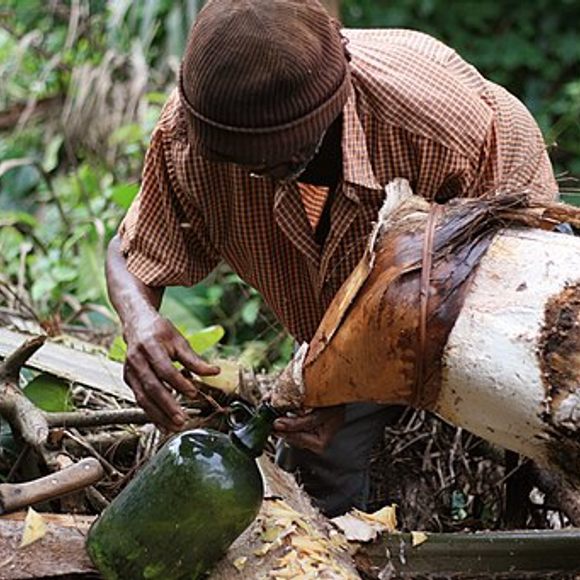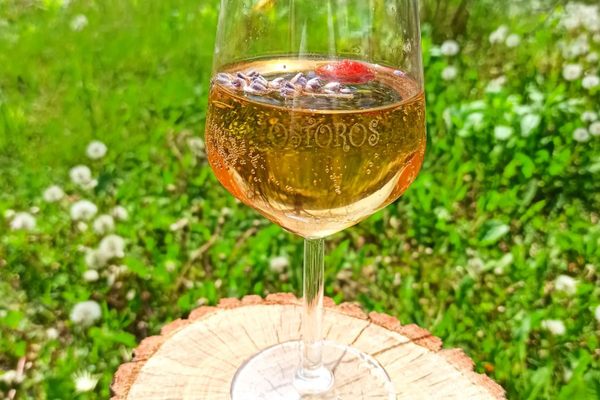Although palm wine has a long history, the window to enjoy it is short.
The clock starts ticking when someone taps palm wine’s only ingredient: sap from a palm tree. In just hours, the sap becomes wine with an alcohol percentage of 4 percent, about the level of a weak beer. Within a day, the wine turns into mouth-puckering vinegar.
To tap tree sap, harvesters climb enormous palms or set up ladders. They make careful cuts at the crown of the tree—sometimes cutting and draining entire trees—and place plastic containers at the base to catch dripping sap. The wine immediately begins fermenting, both from yeasts in the air and from the remnants of wine left in the containers to add flavor. Raffia palms, coconut palms, date palms, and oil palms all produce the sugary liquid that turns into palm wine.
Fans describe palm wine’s taste as milky and powerfully sweet, growing more sour and yeasty with time. But unlike a merlot, the taste changes in minutes rather than years.
The abundance of trees, coupled with the ease of the fermentation process, makes palm wine a contender for one of humanity’s oldest libations, perhaps dating to 16,000 B.C. “Palm tapping for beverage purposes is a pantropical practice, but has its greatest historical depth in Asia and Africa,” writes palm expert Dennis V. Johnson. Those same factors make it just as popular today. West Africans drink palm wine at birthdays, funerals, weddings, and cafe-like palm wine stands. The beverage also serves a traditional purpose: Fiancés gift palm wine to their partner-to-be’s parents. In countries such as Malaysia and Indonesia, residents know palm wine by different names, but they enjoy it in much the same way.
Palm wine’s pleasures aren’t solely reserved for humans, either. “The earliest primate on the planet, the Malaysian tree shrew, drank a fermented palm nectar all night long,” says Patrick McGovern, scientific director of the Biomolecular Archaeology Project for Cuisine, Fermented Beverages, and Health at the University of Pennsylvania Museum. In 2015, humans even caught chimpanzees in Guinea stealing palm wine from harvesters’ taps.
But the unprocessed nature of most palm wine can have drawbacks. In Bangladesh, where it’s a popular evening drink, outbreaks of the deadly Nipah virus in 2016 were blamed on palm wine after infrared cameras spotted bats (carriers of Nipah) lapping at the oozing sap collected for wine.
Palm wine remains largely local thanks to its countdown-clock fermentation and its tendency to explode when left in tightly sealed plastic or glass bottles. With pasteurization, however, it can have a shelf life of up to two years. Still, palm wine’s ephemeral nature makes it all the sweeter.
Written By
 Anne Ewbank
Anne Ewbank
Sources
- www.nationalgeographic.com/magazine/2017/02/alcohol-discovery-addiction-booze-human-culture/
- www.academicjournals.org/article/article1380644347_Obahiagbon.pdf
- www.eater.com/wine/2015/6/9/8753985/on-the-hunt-of-toddy-palm-wine-in-myanmar
- theculturetrip.com/africa/seychelles/articles/a-brief-history-of-the-seychelles-palm-wine/
- www.liquorista.com/types-of-palm-wine/
- www.npr.org/sections/thesalt/2017/06/30/532959384/meet-the-indiana-jones-of-ancient-ales-and-extreme-beverages
- www.theijoem.com/ijoem/index.php/ijoem/article/view/177/304
- www.fondazioneslowfood.com/en/ark-of-taste-slow-food/palm-wine-2/
- www.npr.org/sections/goatsandsoda/2016/03/22/470803523/disease-detectives-find-a-really-good-reason-not-to-drink-date-palm-wine
- www.fao.org/docrep/X0451E/X0451e04.htm
- www.nabca.org/assets/docs/DNU_MARCH.pdf
















